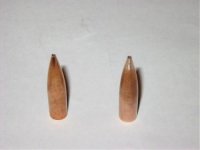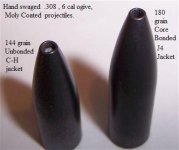trimming and pointing
John,
What's the matter, didn't you think anyone would be able to help you over on the LR forum?? Just kidding, I think I can help you.
Here are my experiences with the bullet pointing die:
The bullet is supported at the base and pushed up into a cone shaped 'insert' in the die to squeeze the meplat down in diameter. The cone angle seems to be a design compromise intended to fit somewhere between tangent and secant ogive, which makes it optimal for neither (as you eluded). The result is a 'step' from the tip to the ogive. This feature is not appealing to the eye, but does achieve the desired effect, albeit, not as good as a smooth junction would. I fully expect shooter to begin experimenting with different shaped inserts matched to specific bullet ogives since the one size doesn't fit all (very well).
Another problem is with uniformity. With meplat trimming, you can achieve uniform meplat diameters because the cutter is indexed off the ogive. This may result in different bullet OAL, but that's less critical than non-uniform meplat. The pointing tool is effectively 'indexed' from the bullet base, which means that longer bullets are pointed more than shorter bullets. With the length variation that' s typical of the long bullets (like 200 and 210 gr .30 cal's), this can lead to a visual difference in meplat diameters. The tool would have to be adjusted for each bullet (not practical) to achieve absolutely uniform meplat.
Now that all the negative stuff is out of the way, I'll say that overall, I believe the process is worthwhile, and I do point my Berger 155 VLD's for Palma, and my Berger 180 VLD's for 'any rifle'. The variation in meplat diameter that I spoke about with the longer bullets is not really a big problem. For example, before pointing, meplat diameters may range from .068" to .072". After pointing, they may range from .055" to .059". Even though it's still .004" variation, look at the percentages (percentage of tip diameter to caliber). Originally, the variation was 22 to 23%, after pointing, it's 18 to 19% (for a .30 caliber bullet). The variation is still the same, but the average is lower. Pointing also rounds off the rough edges sometimes found near the tips. As far as improving uniformity goes, it might make an improvement, but it's not as effective at uniforming as meplat trimming is.
The real reason to employ this practice is for what you were talking about, increasing BC. I've been doing a lot of serious testing of late in this area using acoustic sensors for time of flight at long range and have been making very repeatable measurements (+/- 1% of BC testing the same bullet type on multiple days). My measurements indicate that the improvement in BC is real, but not as significant (10%) as Mr. Whiddon claims. For a .30 caliber VLD, for meplats pointed from .070" down to .053", a BC increase of 4% was measured. Before you scoff at this, the effect at 1200 yards is: 18" less drop, 6" less wind drift, and 44 fps more remaining velocity for a 210 grain .308 bullet fired at 2600 fps. Although not 10% improvement, the effect is very real.
The amount that you can point the bullet depends on the jacket thickness at the tip. Obviously you can't point to smaller than 2x the jacket thickness. If the tips are small to begin with, you can't effect them very much. If you have some bullets with thin jackets and large tip diameters, these are the ones that stand the most to gain from pointing.
The tool is expensive, no doubt. But once you get the tool adjusted for length (easy with some practice) the process is the quickest and most painless reloading step there is. I can knock out 100 in less than 10 minutes without rushing.
Conclusion:
Point for BC, trim for uniformity. Which of these is most important to you depends on your particular discipline. Most shooters on this BR forum will probably favor trimming over pointing because of the difference between BR and prone shooting.
Good luck,
-Bryan



